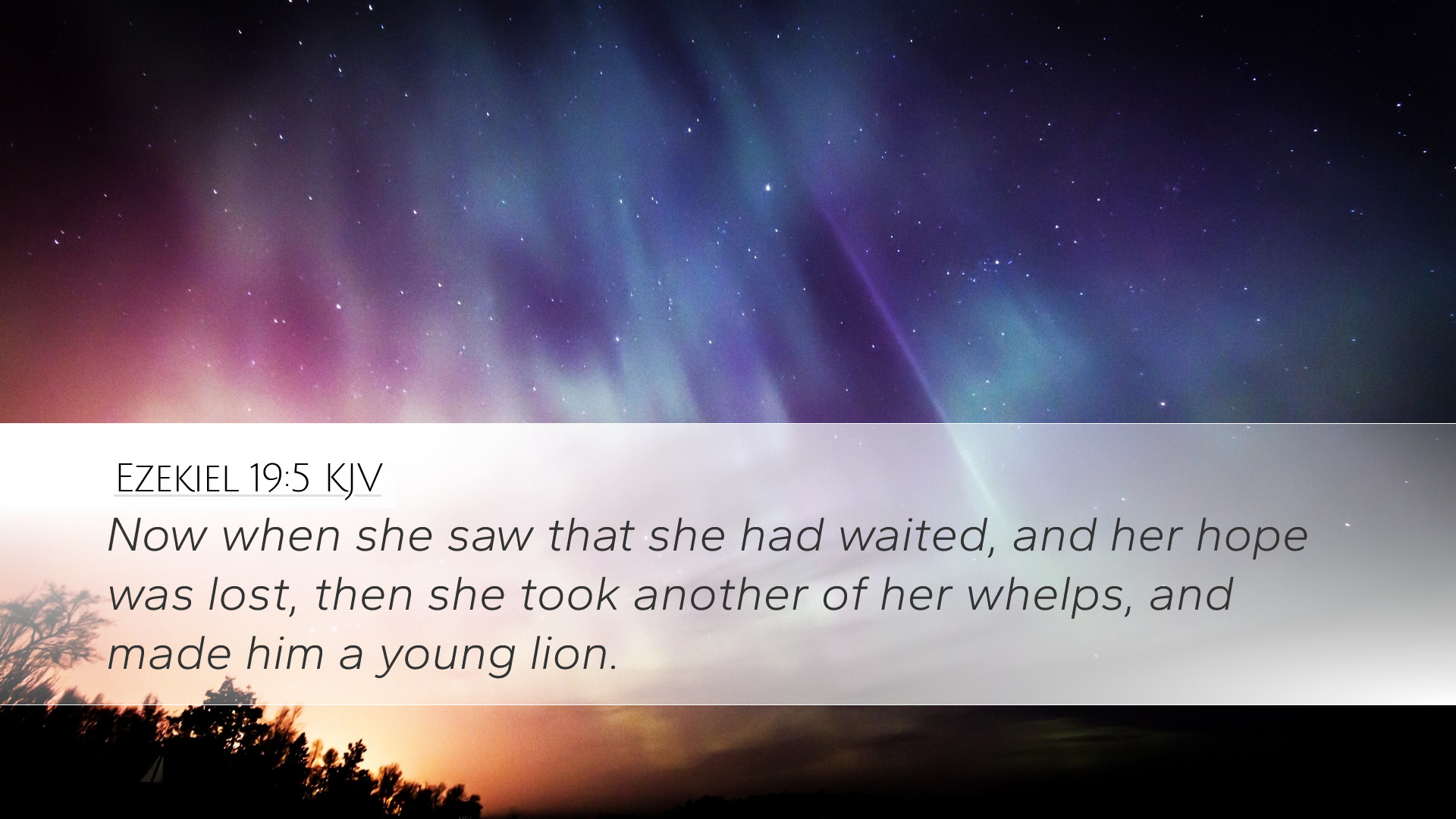Ezekiel 19:5 - Commentary Summary
Verse Text: "But when she saw that she had waited, and her hope was lost, then she took another of her whelps, and made him a young lion." (Ezekiel 19:5)
Overview
Ezekiel 19 presents a lamentation over the princes of Israel, symbolically represented by a lioness and her cubs. This particular verse illustrates the tragic progression from hope to despair, representing the fate of Judah in its struggle against surrounding nations and its eventual downfall. The imagery of a lioness combined with her whelps serves to highlight the strength and potential of the nation, as well as the pain of unfulfilled expectation.
Thematic Insights
- The Lioness as a Symbol: The lioness represents the royal house of Judah, particularly King Josiah and his lineage. The lion symbolizes strength, nobility, and a fierce protective instinct, which indicates the original power and potential of Judah under its leaders.
- The Loss of Hope: The phrase "when she saw that she had waited, and her hope was lost" captures the sense of despair felt by the people of Judah as they witnessed their leaders fall. The longing for restoration is evident, yet the reality of their situation leads to a drastic disillusionment. This spiritual and national disappointment resonates with themes in both the Old Testament prophetic literature and the lives of the faithful.
- The Selection of a Replacement: The act of taking "another of her whelps" and making him a young lion signifies a transition and an attempt to continue the line of leadership despite failures. This act may point to the rise of Jehoahaz, who followed on the heels of Josiah’s noble reign but ultimately led Judah into further disarray. It reflects the continual cycle of seeking hope in new leadership, yet failing to address the deeper spiritual issues.
Commentary Excerpts
Matthew Henry
Henry emphasizes the poignancy of this lamentation, noting that the imagery of the lioness captures the beauty and strength of Judah's heritage. He reflects on the crucial moment when despair set in, and points out how Judah, while striving towards a hopeful restoration, instead became a nation marked by tragedy and broken promises. Henry sees this transition as a cautionary tale for future generations about the importance of righteous leadership.
Albert Barnes
Barnes elaborates on the context of the text, connecting it to the historical narrative of the Israelites and their kings. He underscores the significance of the lioness and her whelps as representative of the leadership that once embodied power and integrity. Barnes notes that the selection of a new leader, despite the failure of past ones, implies a cycle of unfulfilled potential, reflecting the larger theological issue of Israel’s ongoing rebellion against God.
Adam Clarke
Clarke dives deep into the metaphorical nature of the lion’s whelps. He instructs readers to see in this narrative the tragic outcomes of misplaced confidence in human leadership. Clarke addresses the concept of “making him a young lion,” highlighting the deceptive allure of power and authority that leads to even greater national ruin. He points out how this was indicative of the people’s tendency to seek after visible strength rather than to rely on spiritual conviction and fidelity to divine mandates.
Theological Reflections
This verse, while lamenting the state of Judah, also compels deep reflection on the human condition. It serves as a reminder of the often cyclical nature of hope and disillusionment, particularly in contexts of leadership and governance. Throughout biblical history, the pressing need for faithful leadership emerges as a recurring theme, prompting today's leaders to consider the weight of their responsibilities in guiding their communities.
The emotional journey from hope to despair encourages a broader understanding of God’s relationship with His people. As pastors, theologians, and scholars reflect on this passage, they are invited to engage with the underlying truths about reliance on God versus dependence on human agency.
Practical Applications
- Hope Amidst Despair: This passage provides a rich ground for discussing how individuals and communities can find hope, even in seemingly hopeless situations. It encourages an exploration of faith and resilience in the face of national or personal crises.
- The Responsibility of Leadership: For pastors and church leaders, the commentary invites them to assess how their leadership reflects the heart of God. It raises questions about authenticity, moral integrity, and alignment with God’s purposes.
- Reflective Practices: Encouraging a practice of lament within the church community can bring healing and understanding, allowing congregations to express their own struggles before God while seeking His guidance for restoration.
Conclusion
Ultimately, Ezekiel 19:5 encapsulates a profound moment of loss and reflection. It offers a rich tapestry of insights on leadership, national identity, and the human experience of grappling with hope amidst adversity. By engaging with this scripture and the accompanying commentaries, scholars and practitioners can find lessons that resonate deeply with contemporary issues of faith, governance, and communal resilience.


